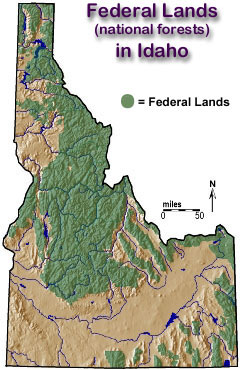
 |
From its beginning, the federal government has been a substantial landowner, and the acquisition and disposition of those lands is an important part of our nations history. The disposition of federal lands has always been controversial and complicated, but in the East and Midwest such lands were disposed of gradually. However, in the mountainous and arid West, huge areas were retained by the federal government because they were unfit for settlement and cultivation.
As new states entered the Union, they were granted federal lands to dispose of in order to support state services, mainly education. As part of the price for admission, they were required by Congress to surrender any future claims to federal lands within their borders.
Since the early days of the republic there has been disagreement about the disposition of federal lands, with many powerful groups agitating for private exploitation. Until 1976, a total of 1.144 billion acres of federal lands were disposed of. From the tenure of President Theodore Roosevelt until the 1970s, environmentalists who favored Washington's control of the federal lands won most of the battles.
Those who wanted these lands to pass into private ownership were alarmed when Congress passed a law in 1976 directing the Bureau of Land Management to hold land "in perpetuity" instead of systematically disposing of it. This triggered what was known as the Sagebrush Revolt, which peaked in 1979. The so-called revolt was an effort by miners and ranchers to give control of the federal lands to the states. One Nevada legislator expressed their aims well "It is time to wrest the land from the perfidious absentee landlord who resides along the banks of the Potomac." This movement had run its course by the early 1980s.
Federally owned or administered lands constitute some 24 percent of the total
land area of the United States; of this federal land, 89 percent is in the American
West, and such lands constitute almost one-half of the total land area of the
eleven most western states. 63 percent of Idaho is federal lands. Four agencies
control more than 99 percent of all federal lands. They are the Departments
of the:
Interior
Agricultureand
Defenseand the Atomic Energy Commission.
The Department of the Interior's Bureau of Land Management controls about 60 percent of the total; the Agriculture Department's Forest Service has nearly 25 percent.
Of the total federal lands, 44 percent is reserved for grazing and 42 percent for forests and wildlife. Less than 5 percent of the total is for defense or atomic energy. The public lands of the West are mainly public domain that have never left federal control, in contrast with acquired lands.
Most of the national parks are in the American West and are intended to safeguard some of the region's most beautiful and primitive scenery. Idaho however, has no national parks at this time - although two national monuments (Hagerman Fossil Beds and Craters of the Moon) and a national reserve (City of Rocks) do exit within the borders of the state.
Wildlife refuges are largely a product of the present century and grew out of opposition to the destruction of many birds and animals as people moved into their natural habitat. The growth of such refuges was made possible by sportsmen's organizations, which recognized that without government control there would soon be few game birds and animals to hunt. These groups were also assisted by a large body of the public interested in wildlife for its own sake and as a source of personal enjoyment and scientific study.